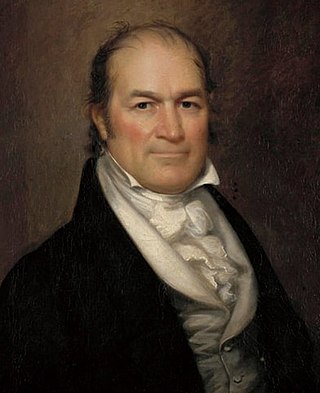
William Harris Crawford was an American politician and judge during the early 19th century. He served as US Secretary of War and US Secretary of the Treasury before he ran for US president in the 1824 election.

William Orlando Butler was a U.S. political figure and U.S. Army major general from Kentucky. He served as a Democratic congressman from Kentucky from 1839 to 1843, and was the Democratic vice-presidential nominee under Lewis Cass in 1848.
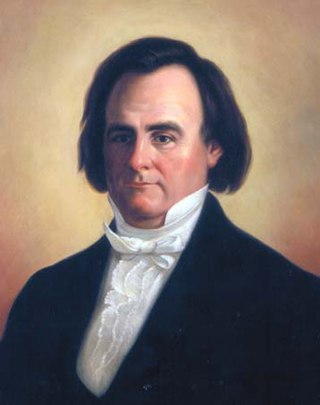
Charles Anderson Wickliffe was a U.S. Representative from Kentucky. He also served as Speaker of the Kentucky House of Representatives, the 14th Governor of Kentucky, and was appointed Postmaster General by President John Tyler. Though he consistently identified with the Whig Party, he was politically independent, and often had differences of opinion with Whig founder and fellow Kentuckian Henry Clay.
The 1814–15 United States House of Representatives elections were held on various dates in various states between April 26, 1814 and August 10, 1815. Each state set its own date for its elections to the House of Representatives before the first session of the 14th United States Congress convened on December 4, 1815. They occurred during President James Madison's second term. Elections were held for all 182 seats, representing 18 states.

The 1812–13 United States House of Representatives elections were held on various dates in various states between August 3, 1812 and April 30, 1813. Each state set its own date for its elections to the House of Representatives before the first session of the 13th United States Congress convened on May 24, 1813. They coincided with James Madison being re-elected president.
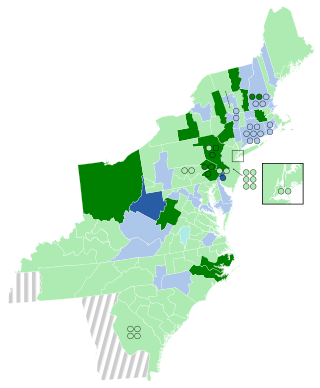
The 1810–11 United States House of Representatives elections were held on various dates in various states between April 24, 1810 and August 2, 1811. Each state set its own date for its elections to the House of Representatives before the first session of the 12th United States Congress convened on November 4, 1811. They occurred during President James Madison's first term. Elections were held for all 142 seats, representing 17 states.
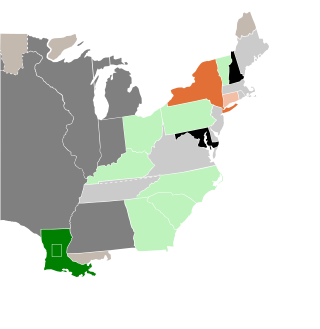
The 1812–13 United States Senate elections were held on various dates in various states, coinciding with President James Madison's re-election. As these U.S. Senate elections were prior to the ratification of the Seventeenth Amendment in 1913, senators were chosen by state legislatures. Senators were elected over a wide range of time throughout 1812 and 1813, and a seat may have been filled months late or remained vacant due to legislative deadlock. In these elections, terms were up for the senators in Class 3.

The 1812 United States House of Representatives elections in New York were held from December 15 to 17, 1812, to elect 27 U.S. Representatives to represent the State of New York in the United States House of Representatives of the 13th United States Congress. At the same time, a vacancy was filled in the 12th United States Congress.

The 1814 United States House of Representatives elections in New York were held from April 26 to 28, 1814, to elect 27 U.S. Representatives to represent the State of New York in the United States House of Representatives of the 14th United States Congress.

The 1812 United States presidential election in Pennsylvania took place as part of the 1812 United States presidential election. Voters chose 25 representatives, or electors to the Electoral College, who voted for President and Vice President.

The 1810 census revealed dramatic population growth in Ohio since 1800, resulting in its representation increasing from a single Representative to six, resulting in the State being broken up into 6 districts, abolishing the at-large district. Jeremiah Morrow (Democratic-Republican), who had served since Ohio achieved statehood in 1803, retired to run for U.S. Senator, so that all six seats were open. Its elections were held October 13, 1812.

Louisiana held its first United States House of Representatives elections following its April 1812 admission to the Union on September 28–30, 1812. A special election for a seat in the 12th Congress and a general election for a seat in the 13th Congress were held at the same time, and had nearly-identical results.

New Jersey kept its delegation at six seats but changed from electing its Representatives on a statewide general ticket to using three plural districts of two seats each. These districts were used only for the 1812 election, and the state returned to using a single at-large district in 1814. This was only the second time that New Jersey used districts.

South Carolina gained one representative as a result of the 1810 census, increasing from 8 seats to 9. Its elections were held October 12–13, 1812.
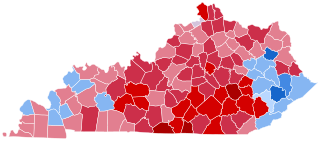
The 1984 United States presidential election in Kentucky took place on November 6, 1984. All 50 states and the District of Columbia, were part of the 1984 United States presidential election. Kentucky voters chose nine electors to the Electoral College, which selected the president and vice president of the United States.

The 1852 United States presidential election in Vermont took place on November 2, 1852, as part of the 1852 United States presidential election. Voters chose five representatives, or electors to the Electoral College, who voted for President and Vice President.

The 1856 United States presidential election in New York took place on November 4, 1856, as part of the 1856 United States presidential election. Voters chose 35 representatives, or electors to the Electoral College, who voted for president and vice president.
John Simpson was a United States Army officer, attorney, and politician. Simpson saw military action in both the Northwest Indian War and the War of 1812. He also served 4 terms in the Kentucky House of Representatives including 2 years as the House's Speaker. In 1812 he was elected to the United States House of Representatives but died before he could take office.

The 1912 United States presidential election in Kentucky took place on November 5, 1912, as part of the 1912 United States presidential election. Kentucky voters chose 13 representatives, or electors, to the Electoral College, who voted for president and vice president.

Elections in the U.S. state of Kentucky are held regularly. Politics in Kentucky has historically been very competitive. The state leaned toward the Democratic Party during the 1860s after the Whig Party dissolved. During the Civil War, the southeastern part of the state aligned with the Union and tended to support Republican candidates thereafter, while the central and western portions remained heavily Democratic even into the following decades. Kentucky would be part of the Democratic Solid South until the mid-20th century.
















